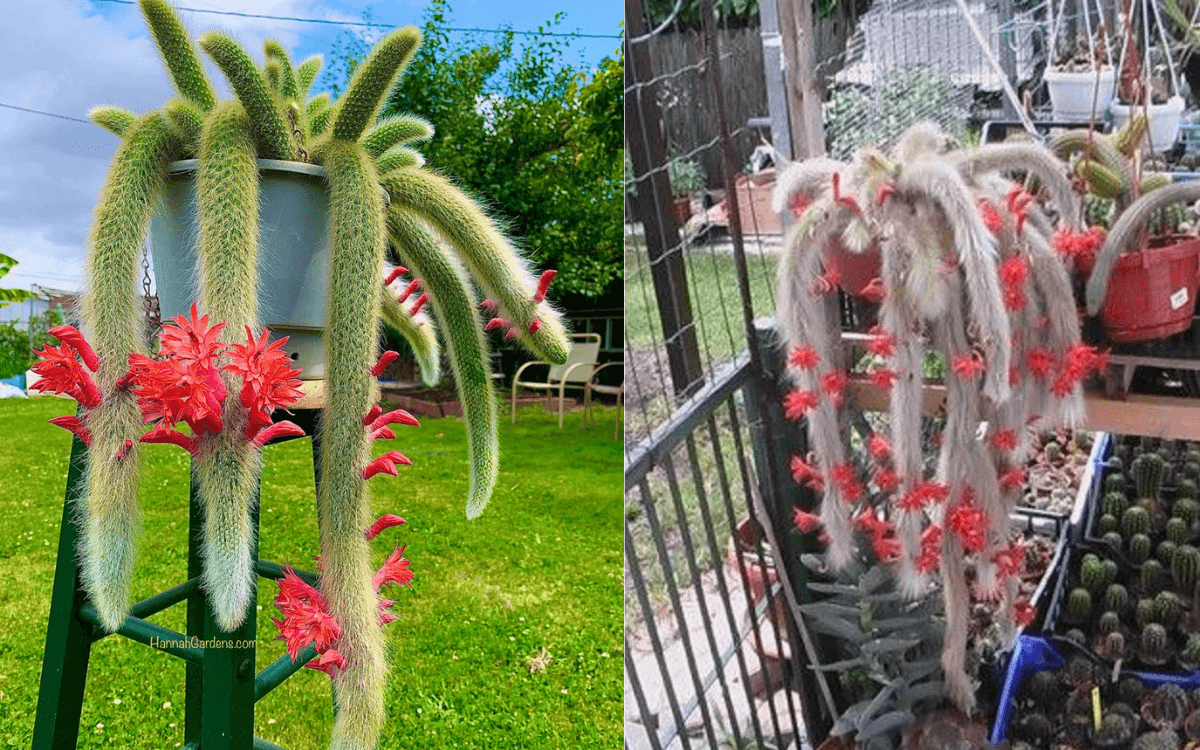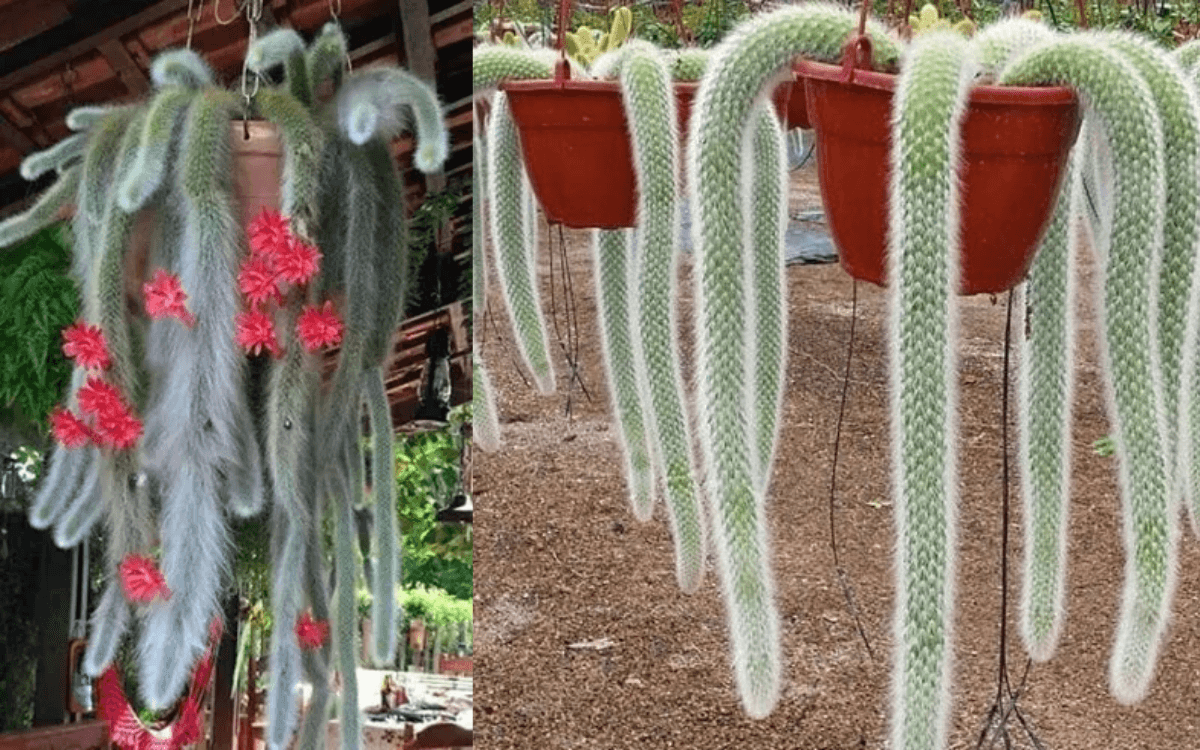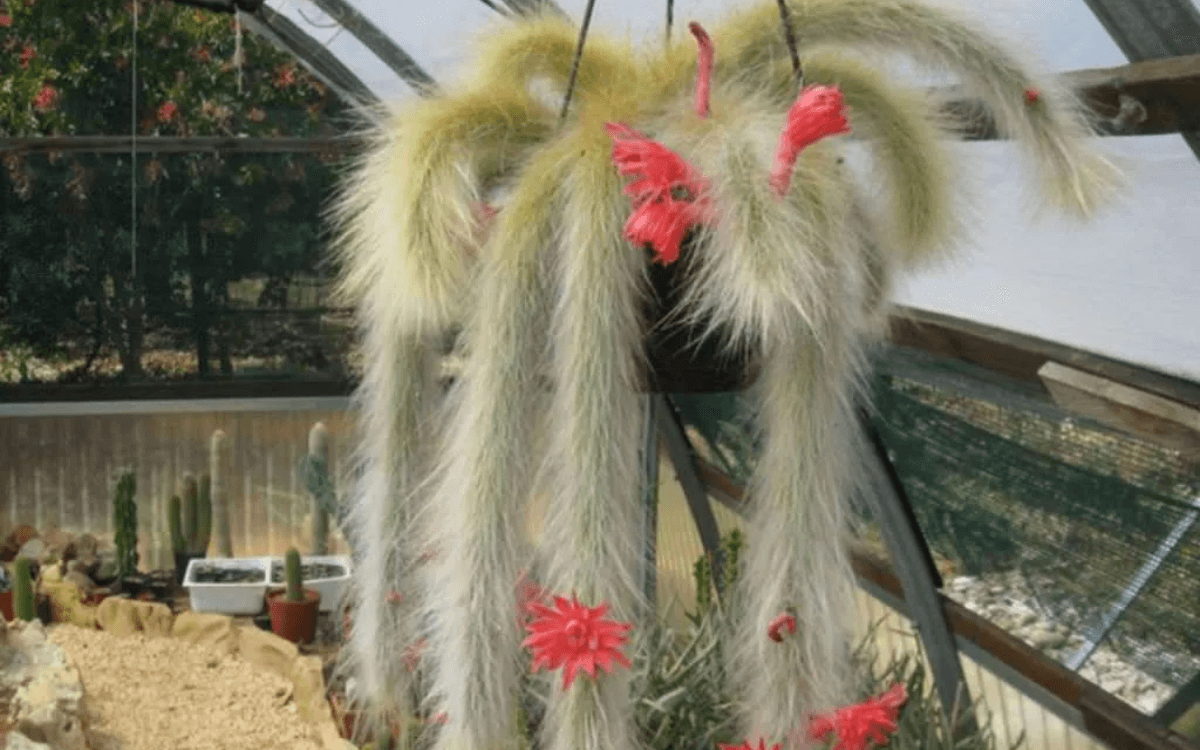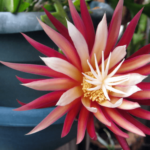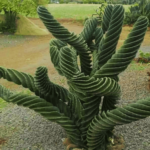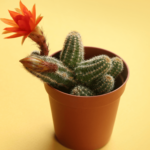The Monkey Tail Cactus is a plant native to regions of Mexico and the southwestern United States.
This cactus, also known as Hildewintera colademononis or Cleistocactus Colademononis, stands out especially for its striking appearance.
With its stems resembling a monkey’s tail and vibrant red flowers, the Monkey Tail Cactus is a great plant to have in your home or garden.
In this article, we will explore its characteristics, curiosities, and the necessary care to keep this species healthy.
Plant Characteristics
The Monkey Tail Cactus is distinguished by its long, soft white spines, resembling fine hairs that cover its light green stems. These features give the plant a unique texture and distinctive appearance, making it an exceptional decorative element.
In spring and summer, the cactus becomes even more attractive with its vibrant red flowers.
With its pendulous growth, this cactus is perfect for cultivation in hanging pots or in spaces that allow for its free development and extension.
Moreover, the plant reproduces and propagates easily, whether by seeds, shoots, or cuttings, making it easy to grow even for novice gardeners, enriching any environment with its unique and exotic beauty.
How to Care for the Monkey Tail Cactus
Cacti are considered easy to grow plants, however, they require some care to bloom and be healthy.
Below I will delve deeper into the care you need to provide for your monkey tail cactus to be successful.
Lighting
The Monkey Tail Cactus needs plenty of direct sunlight.
It is recommended to receive at least six hours of sun per day.
In colder climates, sun exposure should be gradual, while in hot climates, the plant can benefit from partial shade or filtered light to prevent burns.
Temperature
During the day, the ideal temperature ranges from 20°C to 30°C (68°F to 86°F), with cooler temperatures at night.
However, the plant is tolerant of variations, growing well in temperatures ranging from 5°C to 15°C (41°F to 59°F) in winter. To produce abundant flowers, the cactus needs this cooling period in winter.
If temperatures fall below 5°C (41°F) for more than two or three days, it is essential to protect the cactus with a shelter or, if in a pot, transfer it to a protected indoor location.
Humidity
The Monkey Tail Cactus thrives best in a dry environment.
Avoid excess moisture, as the plant is excellent at storing water.
Ventilation
Good air circulation is crucial for the Monkey Tail Cactus.
Ensure that the plant is in a location with adequate ventilation to prevent diseases caused by excess moisture.
Ideal Soil
This cactus prefers a well-drained, light, and slightly moist soil, which is also capable of retaining enough oxygen for healthy root development.
The ideal soil for the Monkey Tail Cactus should be rich in minerals, creating a conducive environment for root growth.
A mixture composed of sand, perlite, and vermiculite is recommended to ensure adequate drainage, avoiding water accumulation.
It is important to use a substrate with low organic matter content that tends to retain a lot of water.
Incorporating pebbles into the soil can help maintain the necessary moisture without causing waterlogging, benefiting the cactus’s root system.
The soil pH should be kept at a neutral to slightly acidic level, between 6.5 and 7.5. Soil that is too acidic or alkaline can be harmful to the cactus.
Fertilization
For the Monkey Tail Cactus, the use of NPK fertilizers is recommended, especially those with ratios of 04-14-08 or 15-15-20.
These formulations provide a balanced combination of Nitrogen (N), Phosphorus (P), and Potassium (K), essential nutrients for plant growth.
Moreover, it is advisable to opt for fertilizers specific to cacti and succulents, which generally contain less nitrogen and higher amounts of phosphorus and potassium, helping to avoid the accumulation of toxic salts in the soil.
Fertilization should be carried out during the active growth period of the Monkey Tail Cactus, from spring to late summer. During this period, the plant absorbs more nutrients to support its growth.
The recommended fertilization frequency is approximately once a month or every two weeks, following the manufacturer’s fertilizer instructions.
It is important to dilute the fertilizer in water before application to avoid root burn and apply it only to moist soil, never dry soil.
Avoid excessive fertilization, as an excessive amount of fertilizers can be harmful, causing growth problems and potential root burn.
During winter, when the cactus enters its dormancy period, fertilization should be avoided.
This rest period is vital for the plant’s life cycle and preparation for growth in the next season.
How to Water
Proper watering is vital for the health and development of the Monkey Tail Cactus, this cactus needs special watering care, very different from what is necessary for other houseplants.
The frequency of watering should be based on checking the soil moisture. Water the plant only when the soil is completely dry.
Generally, it is recommended to water about once a month during spring and summer, reducing the frequency in autumn and winter. When watering, moisten the entire soil evenly, avoiding puddles and watering around the roots, not directly on them.
The best time to water is in the morning or late in the day, especially on hotter days. This avoids the intense midday heat and allows the water to be efficiently absorbed before the cooler night temperatures.
Water quality is important; use room temperature water and prefer rainwater or chlorine-free water. Ensure that the pot has good drainage, and if the soil is very wet, wait for it to dry before watering again.
Excess water can be fatal to the cactus, leading to root rot.
Repotting and Multiplication
Repotting is suggested every two or three years to renew the soil and replenish nutrients.
- Choose a pot slightly larger than the current size of the plant, ensuring it has drainage holes. Clay pots are a great option as they help keep the substrate cool and allow adequate drainage.
- Remove the old soil, inspect the roots for signs of rot or infection.
- Use a well-drained and aerated soil; a mixture of sand, perlite, and vermiculite in equal parts is recommended.
- Place the cactus in the soil, leveling the soil surface with the base of the plant.
- Water the plant gently after planting and wait for the soil to dry completely before watering again.
To multiply your monkey tail cactus, follow the steps in the video below:
Pests, Diseases, and Other Problems
Below, we explore the main pests and diseases that can affect the Monkey Tail Cactus and I will recommend some complementary studies for you to learn to combat these problems.
The most common pests that can appear on your cactus are mealybugs, mites, and aphids. Learn more about them here.
Regarding fungal diseases, you can identify them by:
- Dark spots on the roots
- Plant rotting
- Plant wilting
This was our complete guide on the monkey tail cactus.
If you want to learn more about cacti, read the article how to care for cacti and mini cacti. And if you want to learn about other plants, check out the articles below:
- Impacts and Uses of Azolla in Agriculture
- Japanese Fern Tree – How to Care and Characteristics
- How to Plant, Grow and Care for Celosia (Step by Step)
- Ixora – A Beautiful Plant to Color Your Garden
- Ludisia the Jewel Orchid – How to Care in 7 Simple Steps
- Nephrolepis exaltata (Boston Fern) – How to Grow and Care
- Stricta Air Plant (Tillandsia stricta) – How to Care Easily
Did you like this text? Then share it on your social networks and leave a comment below.

